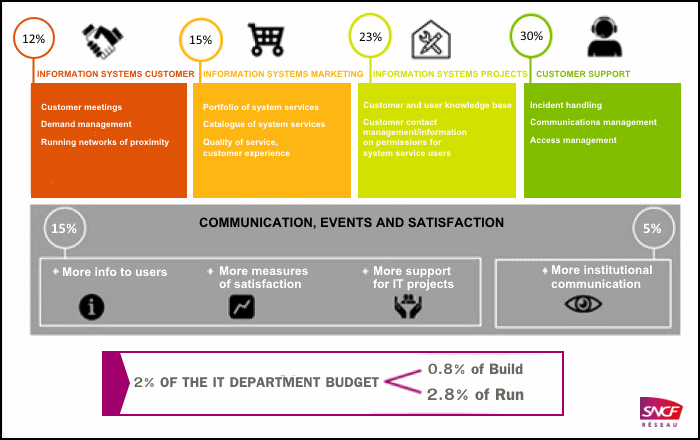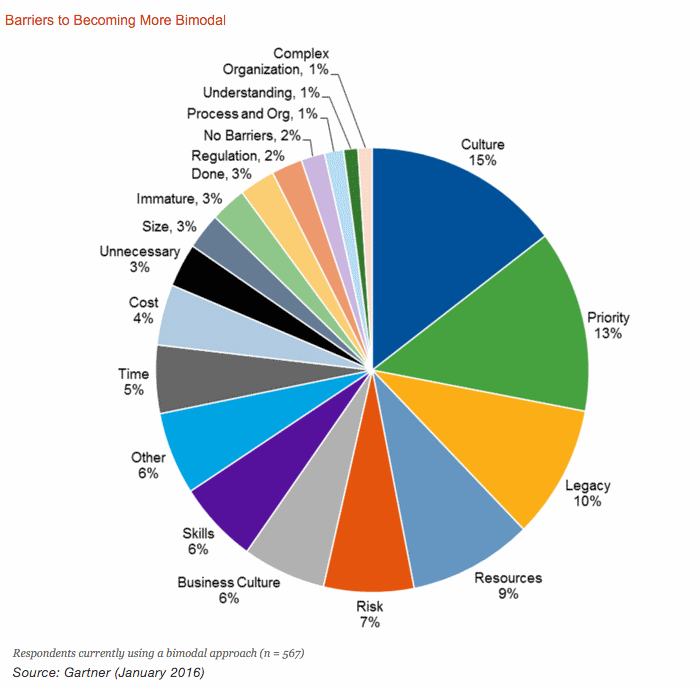Do IT departments really lead the way in digital transformation? Benjamin Protais, Director at Business & Decision Switzerland, explains and expounds his view of the current situation of IT services faced with the digital transformation.

It’s clear that what we are seeing in Switzerland is not a local phenomenon. I’ve also met it in France and it can be generalised to a lot of European countries. Everywhere, many IT departments think that the digital transformation does not really concern them. Either they think that what is at stake in the digital transformation is incompatible with the criteria for assessing their performance (the stability and security of the information system), or they believe that it is for other departments, in particular marketing, to undertake this transformation.
These views, while historically consistent, should be reconsidered in the light of a new paradigm: the re-ordering of roles and responsibilities in IT departments in the digital era and the “real time” factor it has introduced, demanded by departments and customers alike.
A data-centric IT department controls the complexity of the mass of data, the black gold of the digital transformation
At Business & Decision, we are clear that there can be no digital transformation without data, even if they have become uncountable, fast-moving and volatile.
Businesses must get to grips with them and make them intelligible. An IT department controls the complexity of the mass of data, the black gold of the digital transformation. Increasingly, information systems go hand in hand with a data warehouse and big data architecture. In addition, more and more IT departments are providing services that are moving from the traditional reporting/dashboarding for analysis of the past to data science and its promise of predictive power.
However, we must be honest with ourselves. The digital transformation brought major challenges to areas of business that IT departments have been unable to fully address: responsiveness, flexibility, a service focus, etc. With, in consequence, the emergence of systems known as “Shadow IT“).
These are often set up without anyone really understanding their importance. And all this with the complicity of the IT department: either they close their eyes to it, or they insist that they are not responsible. The shadow IT system appeared, and with it the compartmentalisation of information, processes and even teams. I regularly come across this, but it’s not too late.
It can be fixed by imposing this paradigm on those structures IT departments must be at the forefront of digital transformation. They must increase their added value to the business by becoming actively involved in strategic discussions and acting as catalysts for the digital transformation of the company.
The transformation of the IT department is the first success in the digital transformation of an enterprise
For many years, IT departments have walled themselves off as a separate cost centre meeting (or not) the needs of other services. Their “number 1” activity was to manage its SLA and RTO activities and the like while remaining untouchable on ITIL, PMP, etc. Unfortunately their mumbo-jumbo has left them isolated from other services, who have put them to one side in a purely technical role.
Making the best of the IT department means “observing”, “measuring”, “improving” and “promoting”
This involves the following aspects:
- Having a strategy and organisation that encourages proactiveness
- Knowing your market: what market or markets am I operating in? Where am I going, where do I need to sell the IT department?
- Measuring the value that the IT department brings, in business terms
- Develop your customer-oriented approach
- Have an approach based on service and quality of service
- Define the four Ps: product, price, place, promotion
- Develop a unifying and coherent “brand”
- Create cohesion and develop an internal sense of belonging
Source: CIGREG Réussir le Numérique – marketing de la DSI – 2016
Today, as Benoit Ponte, general manager at Yves Rocher Italy, who runs an omnichannel activity, says: “IT departments need to become a business partner and get out of their inwardly-oriented forms of communication. They need to be co-pilots for general management, helping shape strategy, which means they need to be able to convince, to understand the business and what is at stake, and speak the language of business!”
Like the business, IT departments need to transform themselves, become customer-oriented, in other words built around the vocabulary of service, and not that of an IT technician. And to know how to communicate it! For example, the IT division of the SNCF set up its own marketing department a few years ago and dedicated 2 % of its budget to it.

This makes it possible to show the added value of the IT department and to reinstate it as a lasting strategic partner of general management, and as a business partner identified as such by other services.
Not becoming “other” but rather “augmented”. So it needs to retain its traditional pillars: consistency, integrity, security, stability of the information. And add a new way of working to become agile: “test and learn”. This means accepting that some “small” projects will not come off, by defining a budgetary framework from the start along with an acceptable timetable for “learning”. Thus, the conclusion of a POC is sometimes that the concept has not demonstrated its value or its viability! The bimodal IT department is born.
The traditional IT department is dead, long live the bimodal IT department!
I am not speaking from a technological point of view. The bimodal IT department is above all a cultural approach, not a technological dogma. IT departments need to make these two ways of working coexist to address all of the issues facing them while maintaining a coherent information system. In other words, stability of the information system (optimisation of the existing system and applications) and exploration (differentiation vs competition and innovation).
Many structures respond to these challenges by setting up a new digital team alongside the IT division. Although this approach is effective in the short-term, one day or another it will end up creating new silos in the business. So projects to reconcile the technological and the human need to be set under way. That is why I recommend starting the transformation of the IT department as one of the first bricks in the wall.

This is a major challenge since the manager will have to persuade people in contrasting positions to cooperate. Some new people will have come in who do not share the same strengths and weaknesses as those there before them.
And the IT department which can bring together these strengths to create a team consisting of different but consistent talents will be far more effective and audacious than its precursor.
The digital transformation: a global approach, not just a project
Leading the transformation is a time-bound process. The launch phase, which has to ensure the correct direction and provide good visibility, is crucial. It must first provide the business with an overarching plan which sets everyone under way. But at the same time it must deliver quick wins which give the movement shape, show that the path is the right one (or not!) and enable a new way of working.
It is during this phase that we are generally called on. Certain of their needs during transformation, structures have launched projects (digitisation of processes, reworking corporate sites, etc.) But the lack of a guiding thread creates an impression of isolation or, in the worst cases, generates internal tensions and a lack of external legibility (information systems are delivery mediums for corporate strategy!)
The digital transformation of a business is thus a global process which needs to be performed at different speeds. The administrative team must take the initiative on digital transformation (top-down approach) and provide leadership across the board: every department, those “silos”, is involved! They all make their contributions whatever their level in the hierarchy. Implementing this mode of operation is generally the first obstacle we remove: we establish the collaborative model as a rule of the game in order to assist with (but not perform!) the change.
Change management is something done by people
Change management is something done by people and not by technologies. Many ambitious plans for deploying technologies are launched in the vague hope that the tool, through its simplicity, will effect the change by itself.
But as Benoit Ponte underlines: “Colossal projects consume all the energy of the business in their implementation, and promises they make of a revolution in simplicity always fall foul of the ingrained habits of users. People need to be convinced, using “test and learn”, and quick wins need to be achieved to get people on board. It is a mistake to conduct change management using tools alone or via over-ambitious projects.”
This is a strong conviction which we have acquired over recent years. The success of the digital transformation comes above all through a business’s most important asset: human beings.
Dear heads of IT, you have just found your first partner: the HR service whose level of involvement one of the main indicators that we monitor when we start our missions. Its role in accompanying staff through this transformation where skills and some ways of working together are reviewed is key. Employees cannot be transformed in the same way that processes are transformed.
This support must therefore be a key element in projects. For example, the ratio I recommend in terms of effort on the implementation of a corporate social network project is 20 % of the technology for 80 % of the change.
The service-oriented IT department, guarantor of a pragmatic approach to the strategic roadmap!
Still too often I come across structures leading their digital transformation while dreaming that they are different and even … “other”. A successful digital transformation is one that allows you to become what you are: your structure but better, more effective, more accessible, more service-oriented… In other words, your structure, “augmented”. This is not unachievable, but a reality within arm’s reach.
And who is better able to transform ideas into products than the pragmatic approach of IT divisions? Many structures are today facing up to these challenges, and there is the lasting possibility that a two-speed digital society will emerge.
Those who choose the right path are giving themselves every chance of succeeding and tipping the balance the right way.
















Your email address is only used by Business & Decision, the controller, to process your request and to send any Business & Decision communication related to your request only. Learn more about managing your data and your rights.